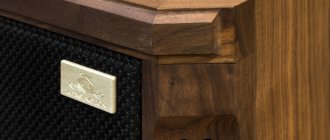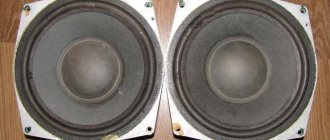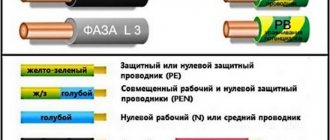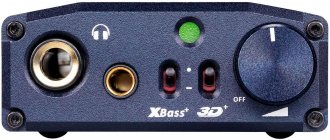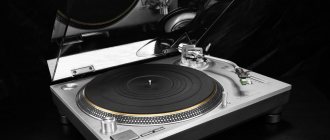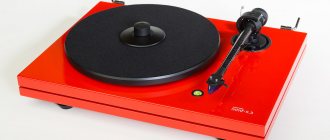Benz-Micro heads have a number of features. These are only MS-type heads; in the designs of older models, wooden cases are widely used, and for almost all models it is possible to select the type of head with different output signal levels. According to my observations, among many manufacturers of “high output” MC heads, Benz-Micro produces one of the best ones.
This review test covered most of the range (with the exception of a few of the highest models) of pickup heads manufactured by the Swiss company Benz-Micro. The specificity of BenzMicro is that the line contains only MS-type heads, and there is not a single MM model. It is also worth mentioning one more feature that already relates to a specific sample of this test. All models were taken in only one of the modifications in terms of output signal level, and the manufacturer produces most of its heads in three versions - with low, medium and high output levels. But during the test we had to limit ourselves to only one modification for each model, especially since, according to experience, although there are differences in sound, they are, firstly, insignificant (and this is a big plus for the manufacturer - not everyone achieves such a result), and secondly, they rather depend not so much on the head itself, but on the selected and suitable (or not quite suitable) phono stage. But of course, low-output heads are preferable. In our case, there is no doubt about the test path, so after preliminary and long running-in (I would say that you need even a little more than the 30-40 hours recommended by the manufacturer) and fine tuning, you can proceed to testing. For comparison, the heads were alternately installed on two identical 12-inch SME M2-12 tonearms with the same cable harness, but the main thing in the test was not comparison, but an attempt to understand what the signature of each specific head is.
Benz-Micro MC-Gold — 12,900 rub.
Lightweight head with plastic housing. Included are only screws for mounting. The needle holder of the head is made of aluminum, noticeably thicker than that of older models, whose needle holder is made of boron. The sharpening of the needle, apparently, is not very sharp. This head is also the only one of the five that has a protective cap. The resonance measured after installation was at 11 Hz, which is understandable given the very small dead weight of the head, so the tonearm shell had to be additionally loaded a little - by 5 g.
The head is more sensitive to the accuracy of settings than I expected. Here I’ll say right away that all the other models in the review turned out to be more demanding in terms of adjustment accuracy than is the statistical average. This head feels moderately confident when it comes to old, battered and unwashed records—medium defects are handled well, but the head clearly doesn’t like sand and an abundance of dust. Mono records sound, again, generally not bad.
The sound as such is moderately softened, not bright, with moderately deep bass, a neat, slightly chambered midrange and dim high frequencies. The presentation is neat, without obvious assertiveness. Detail and dynamics are moderate. The stage is of medium width and depth, not very airy, but not dense either, with correct proportions and good separation of images. There is a certain superficiality in the general character, but there is also a certain musicality, moderate airiness. Attention is primarily given to the main tones and moods, and after-sounds are reproduced a little lightly. Most of all, such a sound would be suitable for medium-budget channels, with pronounced brightness and assertiveness in presentation. If you look at the music library, the head is almost universal, with only a slight tendency toward new vinyl.
Benz-Micro Ace Sl — RUB 29,900.
The head is "standard" weight, the body is semi-open, made of transparent hard plastic. At the same time, just like in older models, it only serves as a kind of frame - the entire head structure is attached to a metal base, which is also the attachment point to the tonearm. The case itself, of course, affects the sound, but it cannot provide serious protection - the internal wiring from the coils is clearly visible, and, for example, I would not dare to blow such a structure with compressed air to remove dust. The measured resonant frequency for this head was about 8 Hz.
This head is not as sensitive to worn vinyl as the previous one - sand is heard less noticeably. The sound is a little softened (which, looking ahead, is present to one degree or another in all heads from this manufacturer). You can hear good detail, the handwriting is rather neutral, maybe there is just a little warmth, a little smoothness, which adds melody and cohesion, but does not spoil the picture as a whole. The dynamics are moderate, but it’s more likely not a loss of speed, but a feeling of unity and unhurriedness. And some minor complaints arise only on complex symphonic recordings, in cases where even a hint of intimacy in the presentation is undesirable. The bass is moderately thick and well structured, the mids are transparent and comfortable, the highs are dim. The stage is wide, deep, with well-drawn, clear images and plenty of air. At the same time, there is no longer any need to talk about lightness in presentation.
This head is much more versatile in relation to different paths, while it is worth taking into account a somewhat softened presentation and moderate sound dynamics.
Benz-Micro MC Gold and ACE H heads
Phono stage Clearaudio Balance+ & Accu+ Useful little things
We have already met less expensive heads from this company in a group test (www.salonav.com/arch/2009/10/052.shtml), but now a couple of more serious models are in line. Let me remind you that the Swiss company Benz-Micro initially specialized in the production of artificial precious stones for the watch industry and supplied stylus to the largest manufacturers of pickups: ADC, Audio Technica Ortofon, Pickering, etc. In the mid-80s, Ernst Benz, the founder of the company, decided to start producing his own MC cartridges and vinyl accessories. The most expensive heads are made by hand at a factory in Switzerland, while the simpler ones are made in Japan on fully automated lines. Company representatives carry out 100% quality control of manufactured products.
Both models belong to Series 2, which uses innovative materials and precision in the manufacture of parts. Thus, due to precision winding of the coils, it was possible to reduce their weight by almost half, and an elastic compound developed for the aerospace industry is used for suspension.
The MC Gold head truly appears to be cast in gold. Of course, with a mass of 5.7 g and a price of 10,307 rubles. this is unrealistic - in fact, the body is made of aluminum with a subsequent 24K electroplating. The cantilever is made of hard aluminum alloy, the needle has an elliptical profile with a sharpening of 0.3 x 0.7 mm. The output voltage is typical of most low output MC heads - 0.4 mV. Downforce is recommended within a fairly narrow range of 1.7 - 1.9 g. It would be worth noting that the MC Gold model is included in the list of recommended components in Stereophile magazine.
The head is packaged in a paper box with foam filling, which also contains mounting screws, a non-magnetic screwdriver, a miniature brush for cleaning the needle and a bubble level.
Model ACE (stands for Advanced Cartridge Engineering) is handcrafted in three variants: L, M and H with outputs of 0.4, 0.8 and 2.5 mV respectively. It is noteworthy that the increased generator voltage is achieved each time not by increasing the number of coil turns, which would lead to an increase in mass and inertia, but by optimizing the design and strengthening the magnetic system. The ACE H head (RUB 19,730) can be connected to a standard MM corrector directly, without a step-up transformer or pre-amplifier. This is a decent saving, incl. and due to the removal of excess cables from the path.
The body is cast from transparent blue acrylic, and the elegant design, as if on display, gives the head a unique charm. The cantilever is a boron rod with a diameter of 0.28 mm; a polished diamond with a linear contact (radius 6 x 40 µm) is attached to its tip. The moving system is very flexible (compliance 15 x 10-6 cm/dyne), which makes it possible to use lightweight tonearms, although the description recommends designs with medium to high effective mass. The resonance of the moving system with the MA-505 tonearm (effective mass 14.5 g) was about 8 Hz, due to which intermodulation at low frequencies was almost not felt.
It is recommended to set the downforce even more accurately than that of MC Gold, within 1.7 - 1.8 g. Here you can’t do without precise electronic scales (see the “Useful little things” section).
The manufacturer also stipulates a break-in time: 30 hours for MC Gold and 40 for ACE H. The Clearaudio Cartridge “Break In” Test Record disc helped a lot, reducing the duration of the procedure several times.
I've already noted that the lower register of the Benz Micro heads is outstanding. On the Supermax disc [2] it is emphasized during recording, but I did not notice any artifacts - indistinctness, monotony or obvious limitation from below. MC Gold's bass seems a little heavy, while ACE H's bass is impeccable in this regard. With an ATI P100 studio preamp that deviates within ±0.2 dB of the standard RIAA curve, both heads deliver bright, detailed sound with fine microcontrasts.
But ACE H builds the stage a little differently - the instruments in it are located closer to the listener and seem more prominent. On vocals, the articulation is a little clearer - on Joe Dassin's recordings [3] you can hear a characteristic sound when the lips part. In addition, in direct comparison, the ACE sounds more transparent, without the slight veil that can sometimes be felt with the MC Gold.
Otherwise, the character of both heads is very similar: a confident, energetic middle, a contrasting top, impeccable transmission of the rhythmic pattern. And, of course, energy, although in the interpretation of ACE H the blow seems sharper and stronger.
| Declared characteristics of Benz Micro heads | ||
| MC Gold | Ace H | |
| Type | MS | MS |
| Reproducible frequency range, Hz | 20 — 25000 | 20 — 20000 |
| Output voltage (3.54 cm/s), mV | 0,4 | 2,5 |
| Channel separation (1 kHz), dB | >30 | >35 |
| Channel unbalance (1 kHz), dB | <1,2 | <0,5 |
| Needle profile | Ellipse | Nude Line |
| Needle radii, mm | 0.3 x 0.7 | 0.006 x 0.04 |
| Optimal downforce, g | 2 | 1,7 — 1,8 |
| Optimal vertical angle, degrees. | 23 | 20 |
| Dynamic compliance, cm/din | 15 x 10-6 | 15 x 10-6 |
| Cantilever material | aluminum | boron |
| Internal resistance, Ohm | 120 | 95 |
| Optimal load resistance, Ohm | 200 — 47000 | 200 — 47000 |
| Run-in period, hour | 30 | 40 |
| Weight, g | 5,7 | 8,8 |
| price, rub. | 10300 | 19730 |
share
Tags: Benz-Micro
Benz-Micro Glider Sl — RUB 39,900.
Structurally, this head is more unusual than the others. There is no case as such - only a kind of metal frame. Due to this, part of the wiring from the coils is exposed, and the head requires especially careful handling. The kit includes screws of various lengths, a brush for cleaning the needle, and an individual passport with factory measurements of a specific instance of the head. The measured resonant frequency is 9 Hz.
The presentation is the most neutral among all tested, with the least pronounced softening. The head reproduces records with defects well, but is noticeably sensitive to dust and dirt. Mono recordings sound just as good, especially the later reissues. The stage is moderately wide, deep, precise and airy. The dynamics and detail are quite high. The frequency range is transmitted smoothly, without coloration. The bass is not very large, but fast, light and accurate. The mids and highs are clean, cohesive, neat, without coloration or warmth, just slightly softened. At the same time, there is a certain density and richness in the sound, which goes well with the generally analytical style. The head is quite universal in terms of genre and copes with a wide variety of records in approximately the same way. It worked very well with classic rock - without overly feigned brutality and without obvious emphasis on some of the problems of the recordings.
The style allows this head to be used in a variety of systems and for different music, although you shouldn’t expect any pronounced “rolliness”. I would also be wary of using this option in systems with lean treble frequencies.
Moving coils
True, recently the company's name has been mainly associated with scandals between it and its American distributor, as a result of which curious audiophiles learned a lot of interesting things about ZYX's pricing policy. These events, however, did not in any way affect the sound qualities of the heads. The junior model of the ZYX Bloom brand line has arrived in our laboratory. Outwardly, it looks original, but quite modest against the backdrop of luxurious Ortofon products. The main developer and head of the company, Hizayoshi Nakatsuka, counted many important elements in the design and production process of the MC cartridge, which are responsible for the final sound quality, and focused his attention on them. Among them, it is necessary to highlight the rules for winding coils, grounding the head, housing design and much more. The moving system itself was called Real Stereo Generator, thus hinting that only ZYX heads are capable of providing correct channel separation and proper stereo effect. In addition, the company prefers to use exclusively acrylic as the body material. Moreover, the less it is, the better. As a result, the Bloom weighs just 5g, which can be a problem for some modern tonearms. In such cases, it is necessary to weigh down either the shell or the counterweight. Also noteworthy is the absence of threaded through holes - ordinary ears are used to attach the cartridge to the shell. Other characteristics are quite traditional. The flexibility of the suspension is 15 x 10-6, the rather short black needle holder is made, judging by the name of the material, from an alloy of aluminum and magnesium. The needle itself has a complex hyper-elliptical Line Contact sharpening. The output voltage level of ZYX Bloom is 0.48 mV, which according to the company's classification is considered a high value, since there is also a version with a low output of 0.24 mV. ZYX Bloom sounds completely different from all other cartridges. It turned out that Real Stereo Generator is not just a pretty name. No other participant has demonstrated such depth of the stage, such volume and air, while the body of the music itself does not suffer at all. The timbres are as detailed and rich as possible, the sound seems very tasty. In some ways, the manner of presenting the material is reminiscent of the Denon DL-103R, but the Bloom plays much more refined and accurately. The powerful low-frequency range is not much inferior to Ortofon Blue in depth, and even surpasses it in speed. The entire rock program is played with a bang. What’s interesting is that when a composition begins with a part of instruments concentrated in the high and mid-frequency range, the impression of a certain lightness and ephemerality of sound arises, every aspect of sound production is analyzed so carefully and in detail. And you already want to criticize the excessive emphasis on this area, when suddenly the powerfully and weightily entering rhythm section makes you forget about the emerging reason for grumbling. The classical repertoire is also a real pleasure. Soaring violins, excellent coherence and just the right tempo create a very believable illusion of a live sound. The only feature that can still stop potential buyers of this unusual head is the sometimes too unusual reading of known records. On the other hand, you can easily get used to the style of ZYX Bloom.
Specifications: Type – pickup head | Name – ZYX Bloom | Signal conversion type - moving coil | Frequency response, Hz – 10—40,000 | Suspension compliance, cm/din – 15 x 10-6 | Output voltage, mV – 0.48 | Internal resistance, Ohm – 8 | Load resistance, Ohm – 100 | Recommended downforce, g – 1.5—2.0 | Channel separation, dB – 25 | Needle sharpening – Line Contact | Weight, g – 5
Benz-Micro Wood SH — 45,900 rub.
The head is mounted in a semi-open heather root casing. The kit contains everything you need for installation: a cleaning brush, a data sheet with individual measurements. The measured resonance was about 8 Hz. This head, like the one next to it in the test, has a very small diamond needle with a sharp sharpening.
In practice, this leads to the fact that even badly damaged records are played well, since the stylus passes along the very bottom of the groove. Hence the criticality towards records that are heavily and even moderately dirty (although the final result will depend more on the type of contamination than on the degree). The serving is juicy, biting, airy, slightly warm. The bass is deep, the mids are detailed and also slightly warm, the highs are neat and soft. The detail is good, the dynamics are not the highest, but there is no shortage as such. The handwriting is a little chamber and a little softened, which can already be indicated as a certain signature feature of Benz-Micro. Also, the richness of textures and shades in the sound, attention to subtle nuances and details is fully present. Quiet sounds of changing intonations are perfectly reproduced. In general, I would first of all like to call the handwriting precise and delicate. The scene is not very large-scale, but quite correct in all respects. Genre-wise, there is some slight inclination towards small and medium-sized compositions and not the heaviest music.
Type
— Digital-to-analog converter
Inputs
— 1 AES/EBU;
3 S/PDIF; 1 optical; 1 pair of stereo analog (RCA and XLR) Sampling frequency
- 32 - 192 kHz
Bit depth
- 16 - 24 bit
Volume control
- in 0.5 dB steps
Balance
- in 0.5 dB steps
Port
- RS 232
ADC used
- Burr Brown PCM 1804
Frequency range
- 20 Hz - 20 kHz
Signal-to-noise ratio
- > 105 dB
Input impedance
- 100 kOhm
Internal signal processing
- 32 bit
DAC used
- AD 1853
Analog outputs
- RCA and XLR
Frequency range
- 10 Hz - 22 kHz
Signal-to-noise ratio
— > 105 dB
Harmonic coefficient
—
Output impedance
— 50 Ohm
Weight
— 6.8 kg
Dimensions (H x W x D)
— 110 x 430 x 390 mm High-quality digital-to-analog converter.
The DAC is a high-quality, remote-controlled digital-to-analog converter designed to convert digital signals with sampling intervals up to 192 kHz into an analog output signal that feeds directly into a power amplifier or preamplifier. DAC provides supersampling and 24-bit conversion. The DAC inherits the legendary electronic design of the Nagra D and Nagra V digital voice recorders, which are used by the world's most renowned music companies and record operators. These exceptional devices have proven that digital audio can capture the emotion and warmth of analog tape and long-playing discs that other digital formats cannot. The DAC design has similar components and control principle, using advanced technology to play your music. Subtle understanding of music.
The Nagra DAC processor is the result of 50 years of experience in developing high-quality audio technology.
Like other Nagra products, it does not compromise on quality. Nagra has already proven that regardless of the technology used - tube or transistor - the final product has a keen understanding of music and sensitivity. DAC extends this principle to the field of Hi-Fi technology. More than a converter.
The Nagra DAC is more than just a converter.
Many of its technologically innovative features take system performance to the next level: • Expanded digital and analog I/O formats • Volume and balance control • 192 kHz/24-bit, upgradable to 192 kHz/24-bit for any input signal • No distortion ATF module • 180 degree phase change • Easy to set up and control using interactive keys • Remote control unit (Nagra RCU) • Large backlit display with automatic brightness control • LED displays for volume, balance and level indication • Software modifications using RS232 ports High technical level audio equipment. The DAC provides upscaling to 192 kHz/24 bit for all input signals. Even 16-bit formats such as CD undergo precise signal conversion. The DAC uses an Adaptive Time Filtering (ATF) module that improves the quality of all signals immediately before conversion by eliminating distortion. Hi-tech.
Electronic wiring diagrams consist of four levels. Since no automated software is capable of meeting our high technological requirements, signal integrity is maintained by appropriate track routing. The signal-to-noise ratio is extremely high, and inter-channel distortion is reduced to the lowest possible level. Advanced Ergonomics The DAC uses a Remote Control Unit (RCU) to provide access to all parameters, including menu navigation. In addition, other Nagra devices such as MPA and PL-L can be controlled using one RCU. Output transformers available on special order. The DAC works with both electrically balanced XLR and unbalanced RCA outputs. For the ungrounded output, custom transformers of Nagra's in-house design are also available.
Benz-Micro Ebony H — RUB 79,900.
Structurally, the head is similar to the previous one tested, but in this case the body is made of ebony. The weight is a little more, but other parameters are similar. The measured resonance is also about 8 Hz. In terms of playing records with defects and mono recordings, the result is qualitatively the same as that of the previous model. But the sound itself is different. The presentation is less imposing, more accurate and collected, with certain analytical features. There is less softness, almost no warmth, and there is clearly more air and movement in the sound. The bass is moderately large, clear and structured. The middle is close to neutral, with excellent transmission of texture and nuances. The highs are a little brighter and more transparent. The detail is high, the dynamics are also at the level - not prohibitive, but there is no shortage. The overall handwriting is delicate and precise. The stage is wide, deep, but light and airy. Attention to detail, nuances and intonation, as well as the naturalness of sound, are fully present. In the case of this head, there are no genre restrictions at all, but listening to something primitive and rough is easier with simpler heads. But the path, in order to reveal all the components, must be at approximately the same level, otherwise the capabilities of the head will not be fully used.

